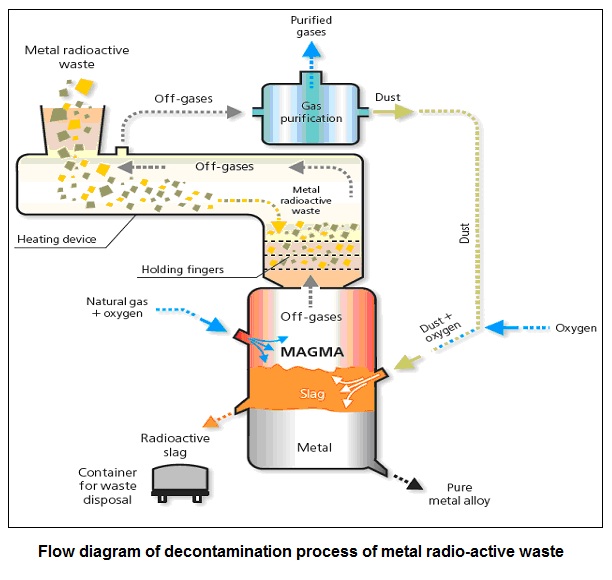Processing of metal radio-active waste in MAGMA
The amount of metal radio-active waste of low and average contamination accumulated in Russia exceeds 1 million tons.
Due to the forthcoming closure and dismantling of outdated equipment of atomic power stations & nuclear fuel cycle enterprises, and the disposal of ships with nuclear power units, accumulation of significant amount of metal radio-active waste is also expected in the future.
Similar situation builds up in a number of industrially developed countries.
Insignificant amount of metal radio-active waste in Russia and other countries is decontaminated by pyro metallurgical method in induction and electrical arc furnaces of low capacity. These smelting aggregates operate non-continuously and due to their design peculiarities, do not provide a sufficient purification of metal. Therefore,metal radio-active wastes are preliminary purified mechanically, hydraulically or otherwise, which is a reason for high cost and small amounts of their processing.
The smelting unit MAGMA allows carrying on pyro metallurgical decontamination of metal radio-active waste continuously, at considerably lower costs of processing.
The process of metal radio-active waste fed into the unit is carried on continuously. Before feeding to the unit, metal radio-active wastes are heated in a shaft heater to temperature 700-800°С. This allows to decrease energy consumption and to increase production capacity of the unit.
Metal radio-active wastes are smelted in a liquid metal bath under oxidizing conditions, which speeds up smelting, improves decontamination of metal radio-active waste and reduces dust formation.
For assimilation of radio-nuclides oxidized and removed from the molten metal, a layer of oxidized slag of low basicity with temperature 1600-1650°C is formed and permanently maintained over the metal. Amount of slag is not high (2-3% of the metal weight).
Decontaminated metal is non-continuously or continuously released to the ladle, to form ingots that are further used as charge in steel production.
Slag contaminated with radio-nuclides is non-continuously released from the smelting unit into containers for disposal of radio-active waste.
The generated oxidized slag of low basicity does not fall to pieces with time and is an ideal substance for absorption and storage of radio-nuclides.
The dust captured by the gas treatment system that contains radio-nuclides is transported by injectors to the molten slag,to assimilate with the slag.
Production capacity of MAGMA for processed and decontaminated metal radio-active nuclide achieves 250,000 tons per year.

Comparative performance of radio-active metal waste disposal –
| Parameter | MAGMA project | Existing companies |
| Decontamination | Pyro metallurgical | Mechanical, chemical, pyro metallurgical |
| Contamination level of the metal radio-active waste being disposed | low, average | low, rare – average |
| Smelting unit type | hermetically sealed, fuel-oxygen, skull body, cooling by a liquid-metal coolant | electrical induction and arc furnaces with refractory lining |
| Type of operation | continuous | non-continuous |
| Volume in terms of metal | up to 100 tons | mainly up to 5 tons |
| Slag ratio | 0.02-0.03 | 0.04-0.05 |
| Production capacity, tpy | 50,000-250,000 | 3,000-7,000 |
| Consumption for smelting of 1 ton of metal radio-active waste:
natural gas, m3 oxygen, m3 electric power, kWh |
100-120 200-240 — |
— — 600-800 |
| Secondary radio-active waste produced, relation to the weight of metal radio-active waste | slag 2-3% | slag 4-5%, refractories 2-5%, radio-active dust 1-2% |
| Limitation in the use of decontaminated metal | 98-99% without limitations | 10-65% without limitations |
| Costs of disposal of 1 ton of metal radio-active waste | 1,000 Euro | 2,000-8,000 Euro |
